| Match Pictures | Matches: 1936 – 1937 | 1936 Pictures |
Trivia
- Unofficial British Championship.
- Celtic & Sunderland played a second match at Celtic Park on 30th Sep
- In the Sunderland goal, Johnny Mapson had replaced Jimmy Thorpe only months after the 22-year-old was the subject of some rough challenges at Chelsea in February 1936, and died after collapsing at his home days later.
- By coincidence, Joe Kennaway was in the Celtic goal having been the one to have replaced John Thomson who died in goals for Celtic in tragic circumstances.
- Referee Harry Nattrass, who had also been in charge of the FA Cup final in 1936.
Review
[….]
Teams
CELTIC:
Kennaway; Hogg and Morrison; Geatons, Miller, and Paterson; Delaney and Buchan; Crum, McDonald and Murphy.
Scorers: McDonald
SUNDERLAND:
Mapson; Hall and McDowall; Thomson, Clarke, and Hastings; Duns and Gallagher; Gurney; Carter and Connor.
Scorers: Carter.
Referee: Harry Nattrass
Attendance: 17,000.
KO: 17:30
Articles
- Match Report (see end of page below)
Pictures
- Match Pictures
Articles

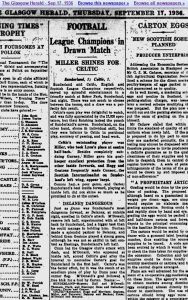
After finishing as runners-up to Arsenal in Football League Division One at the end of the 1934-35 season, Johnny Cochrane’s side came back in style in 1935-36, winning the league title.
Despite going down 3-1 at Highbury on the opening day of the season, Sunderland went top of the league in early November and stayed there until the final fixture of the season in April, to finish eight points clear of Derby County.
To say we were the entertainers that year in English football would be an understatement.
Cochrane’s men scored 109 goals that season, which was 48 more than runners-up Derby County, and 71 of them were at Roker Park. This resulted in two of our side scoring 31 goals in Division One – club legends Bobby Gurney and Raich Carter, with Patsy Gallagher, our third top scorer, netting an impressive 19 goals.
“Special K’s” mags side of the ’90s had nothing on this lot.
Winning that league title meant we were now equal with Aston Villa at the top of the title charts, equalling their record of six league championships. And, as well as being the last time we won the league championship, it was also the last time a team wearing stripes finished top of the pile.
As we prepared for our defence of the league title the following season, we knew that we would be taking part in the traditional Charity Shield, which was that year held at Roker Park – making it one of only six grounds that hosted the occasion for a single year in addition to nine that has hosted the game multiple times.
It wasn’t until 1959 when this fixture became the permanent curtain-raiser for the football season and in the 1936-37 season our fixture with FA Cup winners Arsenal wasn’t scheduled to take place until late October.
A month before that Charity Shield game, however, Sunderland had another fixture to fulfil as League Champions, this time it required our participation in the unofficial British Championship.
This game between the champions of England and Scotland had only begun a few years prior in 1933 as a result of the friendship between the manager of Arsenal, Herbert Chapman, and the manager of Glasgow Rangers, Bill Struth.
Much like the Charity Shield, it had a competitive edge to it, while at the same time having that air of an exhibition where the winners celebrate as if it suddenly became important after the final whistle.
Our opponents would be Celtic, who finished 5 points clear of Rangers and Aberdeen at the top of the Scottish league, which sent thoughts back to 1892 when we played Celtic in a similar game that was then dubbed the “Championship of the World”, which Sunderland won both at Roker Park and Celtic Park.
This time around, both games were scheduled in the opening five weeks of the season, with the first game at Roker Park on the 16th of September. By this time Sunderland had five league games under our belts, and our defence of the league championship wasn’t quite going to plan. We had lost three of the opening five games, and only four days prior had gone down to a hefty 4-1 defeat against Arsenal in the capital.
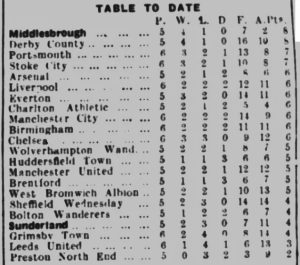
As well as the form the club were in, the fixtures were a source of controversy and opportunity for entertaining visitors to the town.
The controversy was centred around the prices for tickets – the general feeling was that they should be lowered when taking into account the exhibition nature of the fixture. Season ticket holders were able to enter as they would a standard league game, but that still left the majority being priced out of attending the fixture, especially with a home fixture in Division One scheduled only three days later against Brentford.
A letter to the Daily Sunderland Echo and Shipping Gazette summed up the feeling around the pricing of the fixture:
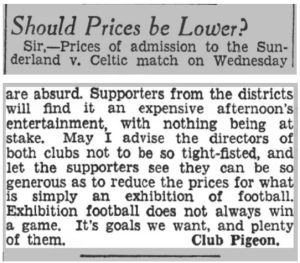
A bizarre story was also reported on the day of the game in the Daily Herald, stating that Sunderland players were banned from playing golf after Tuesday of each week throughout the season. No official explanation was provided by the club, but it was thought to be an attempt to stop the players from going for a round of golf the morning of a game.
Then, there was the tale of the treatment of the crew of H.M.S. Cairo in the build-up to the game. The Sunderland Council General Purposes Committee had decided not to entertain the crew when the ship visited the port on the day before the game. An emergency meeting was then held where the chairman of Sunderland Association Football Club, Sir Walter Raine, described it as an effort to maintain the dignity of Sunderland.
Speaking as chairman of Sunderland AFC, he said that his directors would welcome the officers and men to the match, and he also added that “it is unfortunate that the Socialists should have taken such a foolish action”.
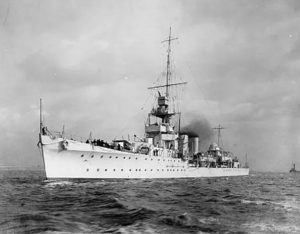
H.M.S. Cairo
From a Celtic point of view, taking the trip South was looked upon as a huge risk given that they would be travelling back to take on rivals Rangers who were up next – as the Dundee Evening Telegraph questioned the wisdom of the timing of the fixture:
Isn’t it strange, therefore, we find Celtic engaged in a mid-week friendly on the eve of their important game with their Ibrox rivals? Not that I am against the Scottish champions meeting the champions of the South. I think it quite a good idea to get to know the relative strength of our teams compared with those across the border. But with all its apparent risk of injury before a match in which the losing of points may be vital at the end of the season – well, I ask you?
Along with the crew of the H.M.S. Cairo, the Journal reported that 17,000 were in attendance for the game which kicked off at 5.30pm. It also hadn’t gone unnoticed, especially in the press North of the border, that Sunderland’s starting XI contained seven Scots, in a side that saw only two changes from the one that turned out against Arsenal in the previous fixture.
Another strange aspect to the starting line-ups was the two goalkeepers. They had both replaced keepers who had tragically died as a result of incidents that occurred on the pitch.
Joe Kennaway in the Celtic goal had replaced John Thomson in 1931 after he had fractured his skull in front of 80,000 at Ibrox in a collision with Sam English. The 22-year-old was taken to hospital but died of his injuries later that evening.
In the Sunderland goal, Johnny Mapson had replaced Jimmy Thorpe only months after the 22-year-old was the subject of some rough challenges at Chelsea in February 1936, and died after collapsing at his home days later.
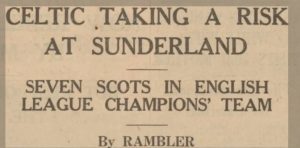
Celtic decided to not risk star-man James McGrory, who was returning to fitness, in their starting line-up. McGrory scored an incredible 502 goals in 477 appearances for Celtic over the course of 15 years, so although he was at the latter end of his career, it was still highly likely that the Sunderland defenders were relieved he missed out.
Referee Harry Nattrass, who had also been in charge of the FA Cup final in 1936, got the game underway. The game would end in stalemate, after Raich Carter had put Sunderland ahead after 20 minutes, only to be pegged back just before the hour by a goal from Malky MacDonald.
According to the report in the Dundee Evening Telegraph, the game was a celebration of football:
As was anticipated, the game was of the most friendly nature. There were no unsightly scrimmages, so common nowadays in league football, and fouls were of a very minor nature. What was the result? – an exhibition of football as it should be played.
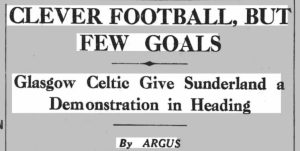
The star of the show according to reports was Newcastle-born Len Duns. The 19-year-old was singled out for praise ahead of his more established teammates, especially for cleverly creating the opportunity that fell to Raich Carter to give Sunderland an early lead.
Praise was also given to the opposition in the Sunderland Daily Echo and Shipping Gazette, with the focus especially on their ability to head the ball which seemed consistently superior to the home side:
Criticism in a friendly match is always out of place because the players look upon the game as a friendly, but in this case we certainly did see some really good football movements, and I think the crowd of just under 18,000 – rather enjoyed it, especially the fine positional play and the headwork of the Celtic side.
During their stay on Wearside, the Celtic players were also treated to attend the first house at the Empire Theatre, and later in the evening, visit the Sunderland Illuminations. Johnny Cochrane’s side meanwhile were focused on the visit of Brentford four days later, and also planning for the return fixture in Glasgow in two weeks time.